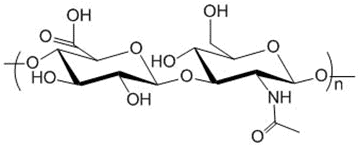Properties
Name and Source: Hyaluronic acid (HA, Hyaluronan, Hyaluronate) is an anionic, non-sulfated glycosaminoglycan distributed widely throughout connective, epithelial, and neural tissues. CAS# 9004-61-9. Our HA products are produced via microbial fermentation. See Documents section for details.
Appearance: White, lyophilized powder.
Solubility: Soluble in water and the solubility data varies with MW. Higher MW results in lowered solubility. Typically solubility ranges 5-50 mg/mL, that is, 0.5%-5%. Buffered solution at pH >6 enhances solubility due to deprotonation of carboxylic acid groups and formation of carboxylate salts. HA derivatives with hydrophobic groups will lower the solubility in water, and adding alcohol or DMSO to an alcohol-water or DMSO-water mixture can dramatically improve the solubility up to 200 mg/mL (20%).
References
1) Synergistic antitumor activity of camptothecin–doxorubicin combinations and their conjugates with hyaluronic acid, Journal of Controlled Release, 2015, 210, 198-207. Text.
2. Reloadable multidrug capturing delivery system for targeted ischemic disease treatment, Science Translational Medicine, 2016, 8, 365, 365ra160, Text.
3. Targeted delivery of hyaluronic acid to the ocular surface by a polymer-peptide conjugate system for dry eye disease, Acta Biomaterialia, Volume 55, 2017, 163-171, Text.
4. A hyaluronic acid conjugate engineered to synergistically and sequentially deliver gemcitabine and doxorubicin to treat triple negative breast cancer, Journal of Controlled Release, 2017, Text.
5. Harnessing the Versatility of Bacterial Collagen to Improve the Chondrogenic Potential of Porous Collagen Scaffolds, Adv Healthc Mater. 2016;5(13):1656-66, Text.
6. Supramolecular Hydrogels Based on MPEG-Grafted Hyaluronic Acid and ÃŽ ±-CD Containing HP-ÃŽ ²-CD/Simvastatin Enhance Osteogenesis In Vivo, Journal of Nanoscience and Nanotechnology 17(1):217-223, Text.
7. Low-molecular-weight polymer–drug conjugates for synergistic anticancer activity of camptothecin and doxorubicin combinations, Nanomedicine, Vol. 11, No. 9, Text.
8. The influence of hyaluronan on the structure of a DPPC-bilayer under high pressures, Colloids and Surfaces B: Biointerfaces 142, 2016, 230-238, Text.
9. Hyaluronic acid induction on breast cancer stem cells unfolds subtype specific variations in stemness and epithelial-to-mesenchymal transition, 2020, DOI: 10.1016/j.ijbiomac.2020.05.236
10. The Role of Hyaluronic Acid in Cartilage Boundary Lubrication, Cells 2020, 9, 1606; doi: 10.3390/cells9071606
11. Injectable hyaluronic acid hydrogels encapsulating drug nanocrystals for long-term treatment of inflammatory arthritis, Bioeng Transl Med. 2022;7:e10245, Text.
12. Hyaluronic acid conjugates for topical treatment of skin cancer lesions, Sci. Adv. 2021; 7 : eabe6627 11 June 2021, Text.
13. Supramolecular host-guest hyaluronic acid hydrogels enhance corneal wound healing through dynamic spatiotemporal effects, The Ocular Surface, Volume 23, 2022, 148-161, Text.
14. Hyaluronan-Sphingosine Polymersomes for Treatment of Ocular Neovascularization: Synthesis and Evaluation, Macromol. Biosci. 2024, 2300531, Text.
Click here to view an expanded list of hundreds of publications citing Creative PEGWorks products.


